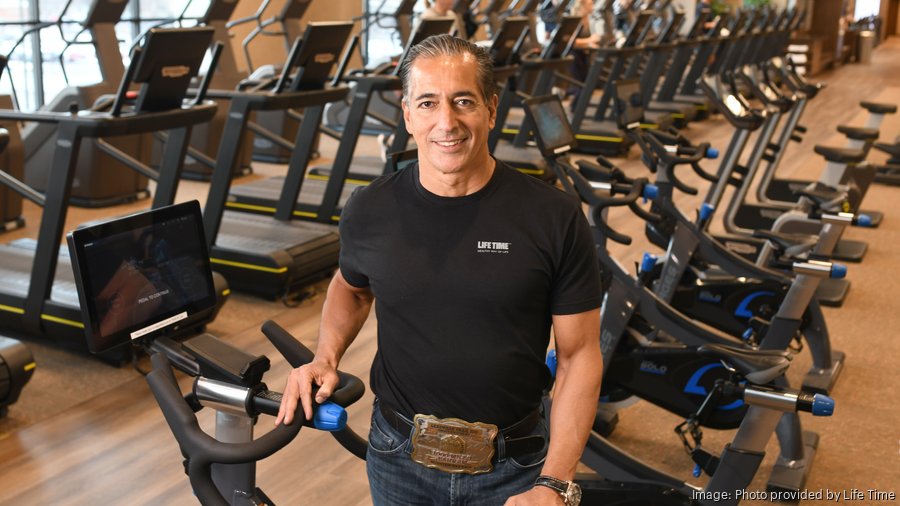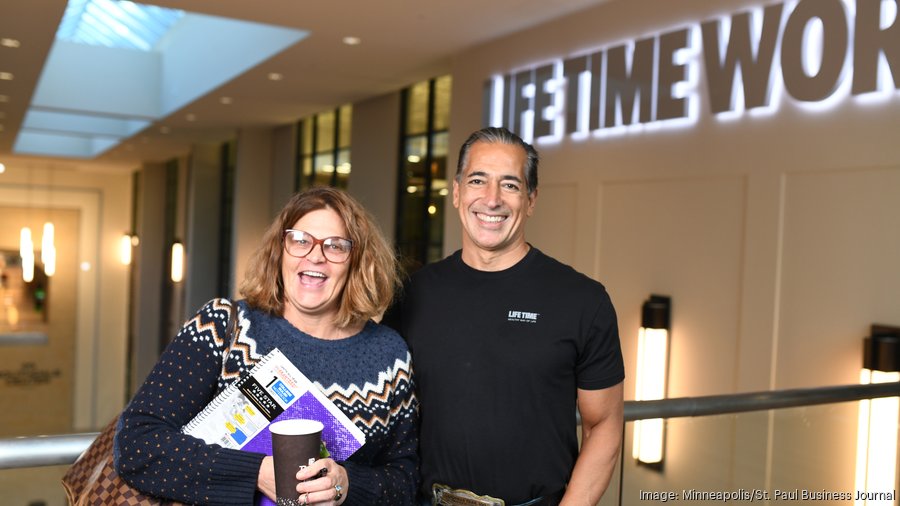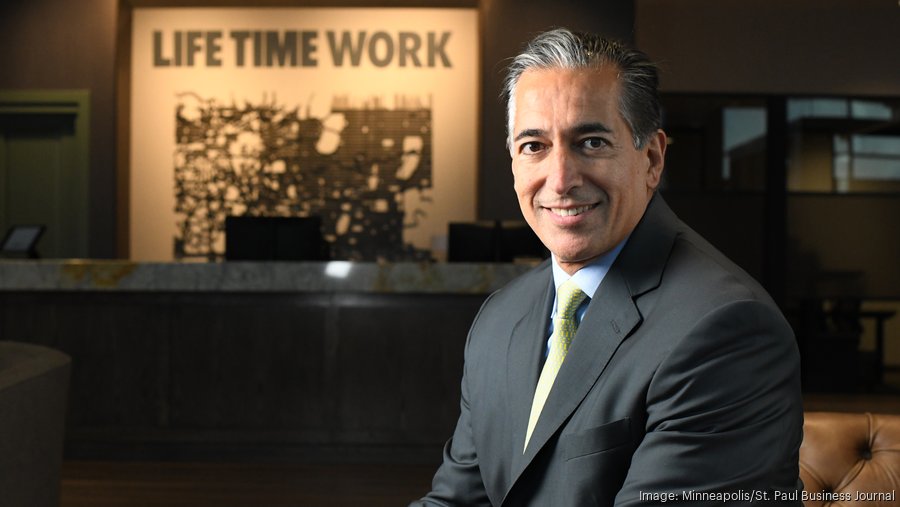The Minneapolis/St. Paul Business Journal has selected Bahram Akradi as its 2020 Executive of the Year, an award that recognizes the outstanding professional and personal accomplishments of business leaders who helm Minnesota's largest companies.
Business Journal staff picked Akradi because of the way he has reinvented Life Time Inc. from a publicly traded health club operator to a privately owned lifestyle company and major real estate firm. In addition to continuing to open high-end fitness centers, Life Time has launched a coworking division, began building luxury apartments, and is leading a reinvention of the shopping mall, which can be seen at Southdale Center in Edina and will expand elsewhere through a partnership with mall operator Simon Property Group.
Meanwhile, Life Time's headquarters is growing with Akradi's ambitions. It's just wrapping up a $30 million expansion of its Chanhassen corporate campus to help accommodate the company’s growing real estate, architecture and engineering divisions.
By any measure, Bahram Akradi had it made by 2015.
From scratch, the Iranian immigrant built Life Time Inc. into a $1.3 billion-a-year fitness powerhouse. His Chanhassen-based company operated 100 clubs in markets all over the country.
But Akradi wasn’t satisfied. Even since Life Time’s early days in 1992, Akradi always had a bigger, broader vision for his company. When he thought about Life Time and its future, he also thought about another industry.
“The railroad industry, at one point, was the biggest industry in the United States, but they were reluctant to think of themselves as a transportation company. They were fixated on being railroads. So then came the airplanes and other forms of transportation and it made the railroad a nonevent. They still exist, but they’re not the biggest part of transportation,” Akradi said during an interview in his office at Life Time’s Chanhassen headquarters.
So Akradi went to work turning Life Time into more than a health club company. He began executing an aggressive plan to build apartments, coworking spaces and hotels near its clubs all across the country. To keep up with this growth, Life Time in February finished construction on a 70,000-square-foot, $30 million office building on its headquarters campus.
In some cases, Life Time is building villages that offer a place for its members to live, work and play. For these villages, Akradi is targeting regional malls, where anchor tenants are dying and leaving other retailers with a loss of foot traffic. Locally, Akradi’s vision is coming into focus in Edina, where Life Time recently unveiled a $43 million health club attached to a coworking space at Southdale Center. This winter, Life Time announced it is working on plans for a 25-story apartment tower that would be attached to the mall and health club.
Life Time is planning to build another two dozen health clubs at regional malls across the country, including several as part of a partnership with Indianapolis-based Simon Property Group, the country’s largest owner of retail property.
As Amazon and e-commerce continue to decimate some of the country’s largest department store chains, Life Time could be a savior of the regional mall and the creator of walkable villages in the suburbs.
Akradi’s vision should take shape in the coming years, but it was a long road getting there.
For his innovative thinking, dedication to his company and commitment to improving people’s health and wellness, the Minneapolis/St. Paul Business Journal recognizes Bahram Akradi with its 2020 Executive of the Year award.

Finding the 'American Dream'
Bahram Akradi is not your typical success story. He immigrated to the U.S. from Iran when he was 17 and enrolled at the University of Colorado-Colorado Springs to pursue an electrical engineering degree. He’d been preparing for a such a career since he was in elementary school, taking a heavy load of science and math classes. He wanted to someday design airplanes.
While in college, he got jobs in the kitchens of restaurants and at health clubs to pay for tuition. During his last semester, he was working for a four-club fitness chain — what would become U.S. Swim and Fitness — selling memberships and making good money. Greg Olson, the president of that chain, asked him to move to Minnesota to open clubs for him.
“I chuckled because I had gone to school for 16 years to be an engineer and you want me to do this?” Akradi recalled. “They made me an offer that was too good to refuse.”
He figured if it didn’t work out, he could go back to engineering. He never did get his diploma, though he completed all the requirements.
By the time he was 22, he said, he was planning, designing and opening multiple clubs, working day and night.
Akradi’s early years in the U.S. were in the middle of the Iran hostage crisis. He downplayed any difficulty in adjusting to life here or being accepted by the community.
“I love my life and I have never felt prejudiced, when some of my friends did,” he said. “I never let it stick to me. … I don’t think that way. I am one of us and you are one of us.”
Eric Buss, who has worked for Life Time for 20 years and is now chief administrative officer, said that even though Akradi downplays it, it was a tough time.
“The hostility toward Iranians in the late 1970s and early 1980s was unbelievable,” Buss said. “He came at the worst possible time for a man from his country to come here. Add that into it, and I tell everyone it’s the greatest American success story that I’ve heard.”
With the help of some commissions he was owed, the owners of the company made Akradi a one-eighth partner.
After they built up the chain, Akradi said, the other partners wanted to sell, though he didn’t want to. They won and Bally Total Fitness acquired the chain in 1986.
Akradi stayed on to operate the clubs that U.S. Swim and Fitness sold, and also to build more clubs. However, within a couple years, he had soured on the company.
“I was as miserable as I was happy before the [Bally’s sale], or as happy as I am today,” he said. “I didn’t believe in their approach to customer service and taking care of employees.”
He said he was making more money than John Elway or Dan Marino at the time (deep into the six figures), but he quit in May 1989 and decided to build the health club chain that he unsuccessfully urged Bally’s to build — Life Time. He wanted to operate large clubs with lots of options, great customer service and attention to detail.
Then came the humbling part. Akradi was in his late 20s and burning through his savings trying to start Life Time.
He wanted to open a large, built-from-the-ground-up club in Eagan to start the company, using only his own money and a bank mortgage. And he wanted to make a big splash in the Bay Area with a half-dozen new clubs. But both of those ambitions were costly.
Instead, he wound up doing exactly what he didn’t want to do, building a relatively small 27,000-square-foot club in a dilapidated Brooklyn Park strip mall on a dirt-cheap lease. He did it on a $300,000 budget, which required him to sell his cars and all of his personal items. He also raised a small amount from investors, including Wheelock Whitney Jr., the Minnesota investment banker-turned civic leader.
He opened the Brooklyn Park club in 1992, worked seven days a week from 7 a.m. to 11 p.m., he said. Several of those early employees are still with him. They ended up selling just enough memberships to break even, and Akradi didn’t take a paycheck for two years.
Eventually the club started making money and Akradi got investors on board, enough so that he was finally able to open the large clubs he wanted — starting with Eagan in 1994.
The company continued to grow through the 1990s and 2000s, expanding to new markets and building more clubs in existing markets. Both Akradi and those early investors were rewarded in 2004 when the company conducted an initial public offering and raised $183 million.
A few years later, the recession hit.

Chief Operating Officer Jeff Zwiefel recalls the Life Time executive team meeting in 2009. He said the company had laid off hundreds of employees working in its architecture and real estate departments as capital dried up, and it pulled back on opening new clubs.
It ended up being an opportunity for Life Time to reposition itself and upgrade its clubs, transitioning from being a mid-market player to a premium, high-quality brand, Zwiefel said.
“That’s where we made a bold commitment to move upstream in the market and not fight it out at the low end. [We worked] to be more of a premium offering. And since then we’ve been continually trying to drive the experience upward and the pricing strategy upward,” he said.
A big driver of Akradi’s early success was his own ability to sell memberships, but also his team’s. So much so that when the Minnesota Timberwolves were struggling in the late 2000s after losing franchise player Kevin Garnett, they turned to Akradi, a longtime season ticket holder, for advice to fill Target Center.
“It was a time when the organization was rebuilding,” recalled Ryan Tanke, who is now chief financial officer for the Wolves. “Our fan base had bottomed out. So we started doing some work with Bahram, picking his brain, and eventually it became a formal partnership. He would host monthly meetings out at his house and we started to really leverage the things that worked at Life Time.”
Akradi has also provided input for the team on its Mayo Clinic Square practice facility and Target Center renovation.
“He’s done just a remarkable job in creating a true experience. You think about every touch point that you have when you go to a Life Time,” Tanke said. “Some of the things that we’re so proud of today at Mayo Clinic Square and Target Center he was very helpful with.”
One of the most important decisions Akradi made when building Life Time was to keep architecture, engineering and construction in-house, which isn’t the typical route for a fitness chain or retailer.
He had a vision for how he wanted to build the clubs, but for them to have all the things he wanted, he had to keep costs down. So he decided to avoid hiring outside firms for that work to save the money those firms would have kept in profits.
“I had to build a vertically integrated company to do all of those things for zero profits — all the engineering, all the construction. There is no profit paid to our own companies for those things, it’s just the cost. That keeps the overall cost of these projects probably 15 to 20 percent less than if you did it a traditional way. We can’t deliver the value proposition we have to our customer today [under the traditional model].”
Going vertical also put Life Time in a good place to expand.
A turning point
In 2014, Life Time raised prices, which caused it to lose some members. Same-store sales dipped, recalled Buss, who had just been promoted to CFO at the time. Life Time’s stock took a nose dive.
That’s when an activist investor, Marcato Capital Management, bought a stake in the company and started pushing for changes. Akradi said he invited Marcato founder Mick McGuire in to explain to him how he was running the company. McGuire, Akradi said, wanted more stock repurchases. Akradi said he was already doing stock repurchases but was more focused on doing what was right for the company.
“The guiding light and the advice I would give to any CEO is that your job is to serve the entity and then take care of everything else. If the entity falls apart, then everyone is done,” he said.
In other words, Akradi said, he wasn’t willing to sacrifice the future of Life Time for a short-term bump in the stock price. He said McGuire left the meeting satisfied.
“I completely made him comfortable,” Akradi said.
Life Time, at the advice of private equity firm Leonard Green & Partners, began exploring a spinoff of its real estate. Around the same time, another firm offered to buy the company, Akradi said.
That firm, Akradi said, was undervaluing the company. So Akradi brought in around 10 firms to make presentations on acquiring Life Time. Akradi also asked Leonard Green to participate — he had been friends with LGP Managing Partner John Dankahl for almost a decade.
LGP eventually partnered with TPB Capital and bought Life Time in a 2015 deal that valued the company at $4.1 billion. Akradi rolled over more than $100 million of his Life Time stock into the newly private company. Earlier offers were for the low $60s a share, Akradi said, and the LGP/TPB deal was $72 a share.
Leonard Green & Partners was attracted to Life Time because of its wide variety of offerings, from basketball and tennis courts to rock climbing to weights and pools, all at a nominal fee, Dankahl said in an interview.
“They’ve effectively taken the place of a country club, and we think that for modern living, that approach is better because it involves the entire family — it’s family-oriented,” Dankahl said.
Going private provided breathing room for Life Time and Akradi to start thinking bigger picture and not having to worry about a bad quarter tanking the company’s valuation.
“After that happened, you know, it really gave us the ability as a private company to really thoughtfully start talking about how real estate and real estate expansion and growth and development can become a really critical part of what we’re doing as a company,” Buss said, noting that Akradi had been dreaming of such a move for years.
By going private, Akradi was able to accelerate the pace of club openings, Dankahl said.
“These clubs are very, very expensive, costing in excess of $50 million apiece to put up,” he said. “It takes them a couple years before they break even. They need to get the membership base up. It’s tough to do that in a public market. As a private company we can make long-term investments. We thought that was a better format for the business.”
After the deal, Akradi shared more of his vision for healthy villages with the private equity firms and they got behind the strategy.

Life Time has already opened three coworking facilities, including two in the Twin Cities. Two more will open this year, in addition to two Life Time Living apartment buildings. Meanwhile, Life Time continues to open new clubs and will cut ribbons at nine more in 2020.
Akradi’s vision to become a developer of coworking office space, apartments and hotels is a logical one. Since he has a staff of 450 architects, engineers and real estate professionals, Life Time has the expertise to do this kind of work.
Life Time has another advantage: Its clubs are massive generators of traffic. The typical club has 3,000 to 4,000 visits per day, with members who typically pay more than $100 a month for access.
“The department stores which have been the traditional drivers of traffic to malls are less in favor than they once were,” said James Cook, director of retail research in the Americas for Jones Lang LaSalle. “So malls are looking for new traffic drivers, and they’ve been turning to entertainment and food and beverage and now fitness is another interesting traffic driver.
“Life Time has realized they are not a fitness center,” Cook added. “They are a lifestyle brand. They want to do things that extend that brand into different arenas, and creating what is almost a wellness destination anchor at some of these traditional malls is a way that they can show that to the world.”
But the health clubs can drive traffic to more places than just malls.
“[Bahram] was observing over time what would happen to the performance of residential apartment units around some of the clubs we built,” Dankahl said. “The residential units would lease up more quickly and the rents would be higher. So that spurred the idea of developing those ourselves.”
Coworking, Dankahl said, tends to skew to a younger worker with irregular hours. Being close to a health club would be mutually beneficial for the coworking and health clubs.
Akradi talks about the Life Time Village idea in bigger, more humanitarian terms.
“I’ve been thinking about how else we can help people be healthy,” he said. “How else can we help people be happy? How can we have a healthy impact on our environment, on our society? And if you want to make sure it’s endless, the vision is really a healthy-way-of-life perspective on our whole globe. How can we make the whole globe be healthier?”
What that means, he said, is that average family in a single-family home takes nine car trips a day. If he builds apartments, offices and health clubs in the same place, he might be able to cut that number by more than half. That means less emissions and less need for infrastructure.
“If I can take five trips out of your daily drive, that’s probably as good if not better than converting 20 percent of the cars to be electric cars,” he said. “We will help the planet.”
Akradi never did get to build the airplanes he wanted to as a kid. But he has succeeded in building his company into something more than a health club.



